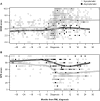Outcome and survival of asymptomatic PML in natalizumab-treated MS patients
- PMID: 25493267
- PMCID: PMC4241803
- DOI: 10.1002/acn3.114
Outcome and survival of asymptomatic PML in natalizumab-treated MS patients
Abstract
Objective: As of 3 September 2013, 399 cases of natalizumab-associated progressive multifocal leukoencephalopathy (PML) were confirmed in multiple sclerosis (MS) patients. We evaluated outcomes of natalizumab-treated MS patients who were asymptomatic at PML diagnosis.
Methods: Analyses included data available as of 5 June 2013. Asymptomatic patients diagnosed with PML by magnetic resonance imaging (MRI) findings and JC virus DNA detection in the central nervous system were compared with patients presenting with symptoms at diagnosis. Demographics, MRI, and survival over 12 months were analyzed. Expanded Disability Status Scale (EDSS) and Karnofsky Performance Scale (KPS) scores were recorded pre-PML, at diagnosis, and at 6 and 12 months post-diagnosis.
Results: A total of 372 PML cases were analyzed; 30 patients were asymptomatic and 342 were symptomatic at PML diagnosis. Classifications of PML lesions on MRI in asymptomatic versus symptomatic patients were unilobar in 68% versus 37%, multilobar in 21% versus 24%, and widespread in 11% versus 40%. In both groups with unilobar lesions, frontal lobe lesions predominated. Prior to PML, mean EDSS and KPS scores were similar for asymptomatic and symptomatic patients. At diagnosis, mean EDSS score was significantly lower for asymptomatic patients (4.1; n = 11) than for symptomatic patients (5.4; n = 193; P = 0.038). Six months after PML diagnosis, asymptomatic patients had less functional disability than symptomatic patients. As of 5 June 2013, 96.7% of asymptomatic patients and 75.4% of symptomatic patients were alive.
Interpretation: PML patients asymptomatic at diagnosis had better survival and less functional disability than those who were symptomatic at diagnosis.
Figures



References
-
- Tysabri (natalizumab) [prescribing information] Cambridge, MA: Biogen Idec, Inc; 2013.
-
- European Medicines Agency. Tysabri (natalizumab) summary of product characteristics. Available at: http://www.ema.europa.eu/docs/en_GB/document_library/EPAR_-_Product_Info... (accessed 19 June 2014)
-
- Polman CH, O’Connor PW, Havrdova E, et al. A randomized, placebo-controlled trial of natalizumab for relapsing multiple sclerosis. N Engl J Med. 2006;354:899–910. - PubMed
-
- Rudick R, Polman C, Clifford D, et al. Natalizumab: bench to bedside and beyond. JAMA Neurol. 2013;70:172–182. - PubMed
-
- Biogen Idec MedInfo. Available at: https://medinfo.biogenidec.com (accessed 21 January 2014)
LinkOut - more resources
Full Text Sources
Other Literature Sources
Molecular Biology Databases
Research Materials

